Most people picture Santorini drenched in sun — whitewashed cliffs glowing against an endless azure sky, bobbing in a glittering Aegean sea. And yes, with over 300 sunny days a year, odds are that’s exactly what you’ll get.
But when my cruise ship dropped anchor in May 2024, I stepped out into a blustery gray morning, wind in my face and sprinkles in the air. After five scorching days in Greece already, I was delighted by the cool, cloudy change — though my travel companion, L (who would happily live in a sauna), was far less enthused.
As others grumbled, I held firm: we were the lucky few who got to see this island wrapped in mist. A rare and moody version of Santorini, mysterious and quiet. I wasn’t cheated — I was enchanted.
Why Santorini Captivates the World
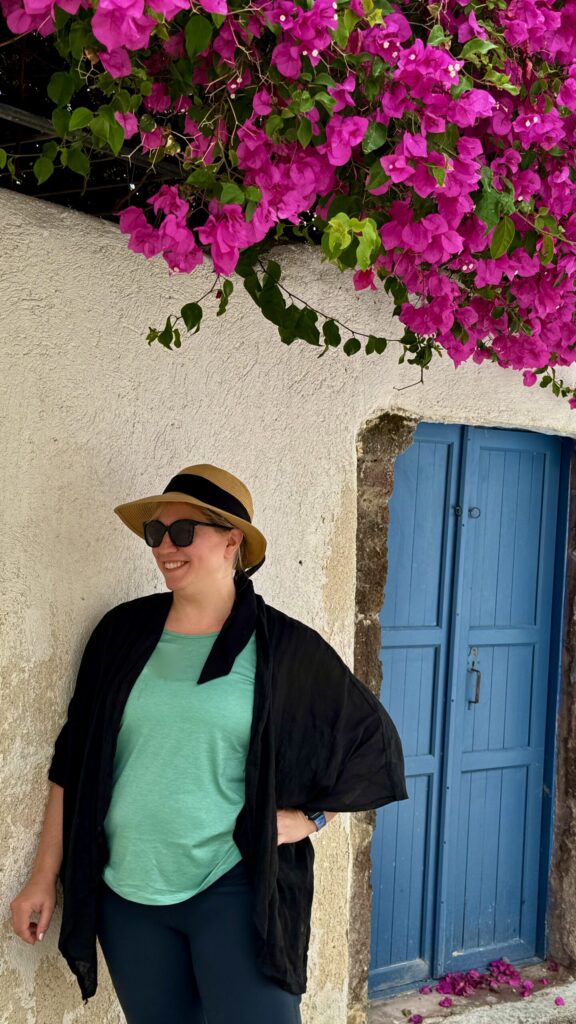
Santorini is part of the Cyclades, one of many island clusters scattered across the Aegean Sea — and arguably the most famous among them. It’s the Greek Island that lives in your imagination: whitewashed houses, sapphire-domed churches, and bright flowers tumbling down cliffside paths above a deep blue sea. While many islands in the region offer similar beauty, those iconic blue domes? You’ll only find them in Oia and Fira, Santorini’s most photographed towns.
The geography alone is astonishing. What looks like one island is actually a volcanic caldera — a ring of islands shaped by ancient eruptions. Santorini (also called Thira) is the main island, but the surrounding islets and the vast central lagoon were all formed by
one of the largest volcanic events in human history. Some 200,000 years ago, the island collapsed inward, creating a massive, water-filled crater. Today, boat tours will take you to hike the still-active volcano, swim in thermal springs, snorkel or dive to see the underwater landscape of reefs and lava formations, and explore colorful beaches made of black, red, or white volcanic sand.
I didn’t have time for those adventures on this visit — but mark my words, I’ll be back. One day I might even get over my extremely reasonable fear of open water and learn to scuba dive, just to see this dramatic underwater world up close. (That, or to finally fulfill my destiny of finding a sunken pirate ship. Either way.)
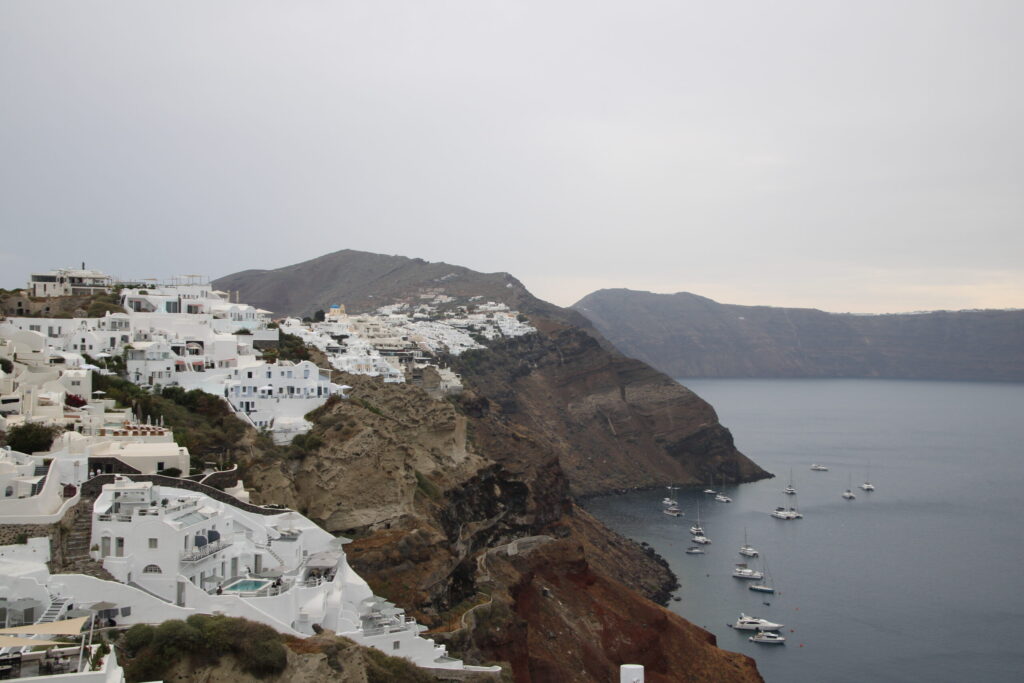
Beating the Crowds in Oia (a Pre-Dawn Power Move)
There’s no cruise ship port in Santorini — a detail I had somehow not considered until faced with it firsthand. Instead, ships anchor offshore and passengers are “tendered” to land via small boats. Once ashore, you find yourself at sea level… staring up at a 300-foot cliff. And your destination? That dazzling white town perched way, way up top.
Now imagine thousands of cruise-goers all arriving around the same time, all trying to get to the top. It’s chaos. It’s a bottleneck. It’s my personal hell.
Thankfully, we had a plan: an early morning excursion booked through our sober travel group. We were first off the ship, into the tenders, and onto a chartered bus that zipped us straight to Oia — ahead of the masses. We also got transfers to Fira and cable car tickets for later, but at that point? We had other plans. The early access alone was worth the price.
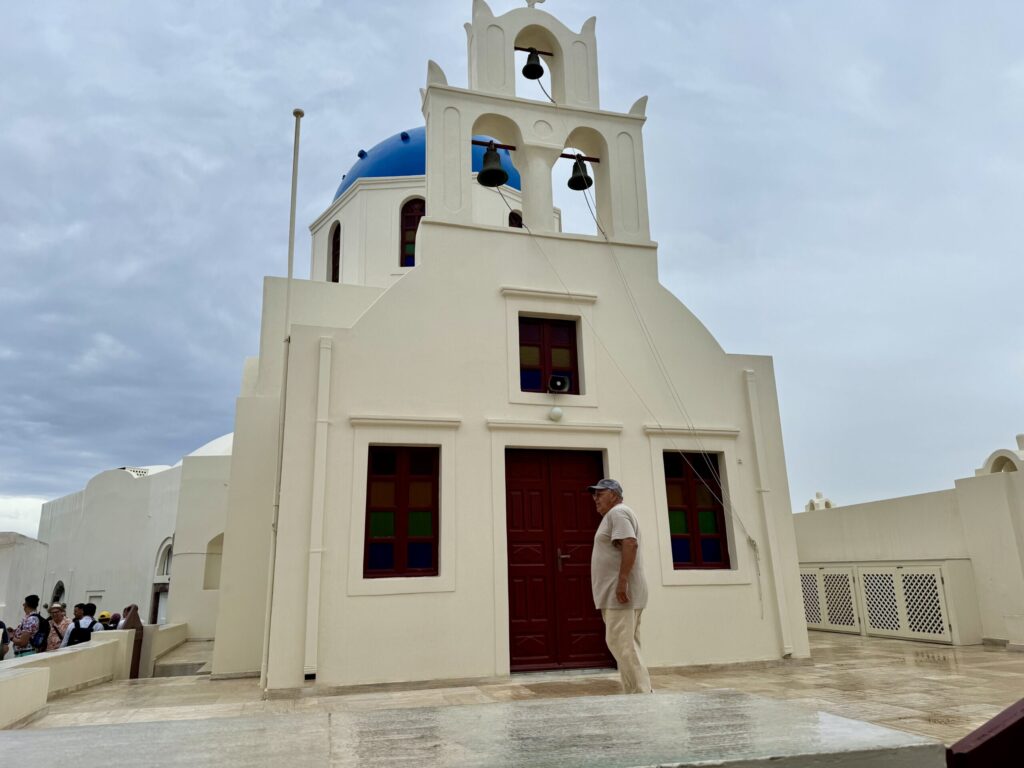
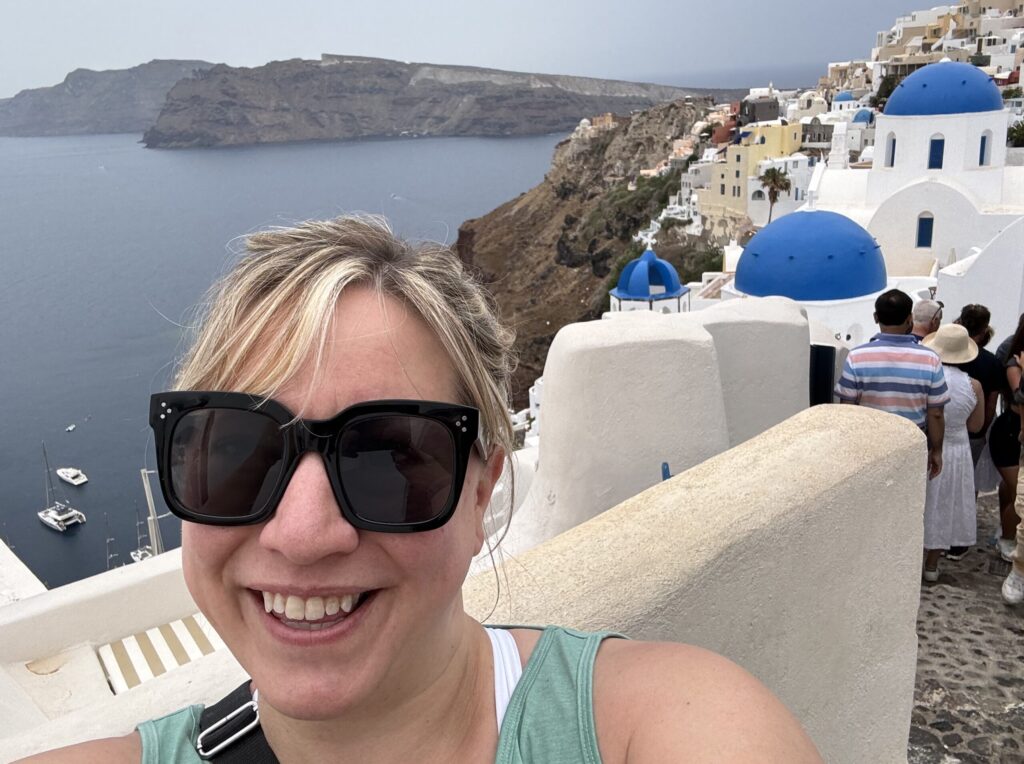
We arrived just as the mist was lifting. The village felt half-asleep, its main square empty and still in the shadow of the Church of Panagia Platsani — a rare and magical moment of quiet in Oia. We had the iconic domes all to ourselves — no jostling, no lines, just uninterrupted views and photo ops. When we finally stepped aside, a queue had already formed, winding around signs and ropes set up to manage the daily tourist surge. (Pro tip: There are two lines for dome photos. One gets you the “perfect” dome shot. The other has a great village backdrop, but less dome drama. Choose wisely.)
Why Hiring a Private Guide Might Be the Best Travel Decision You Make
After soaking up our peaceful moments in Oia (and taking roughly 329 photos), we made our way out of the pedestrian zone and into the world of actual roads — where our real adventure began.
Waiting for us was Giannis of Istoria Travel, our private guide for the day and, as it turns out, part-time tour wizard and full-time Santorini gem.
If you take away only one piece of advice from this post, let it be this: Hire a private guide — especially if you only have a day.
Whether through Airbnb Experiences, a local operator, or someone you first discover on a platform and then book with directly, it’s a total game-changer. You get transportation, tailored insight, historical context, off-the-beaten-path access, and someone who can not only take photos for you, but also make you laugh while doing it.
Giannis was all of that and more. Within minutes of meeting, it was clear we’d scored big. He wasn’t just driving us around — he was curating our experience with passion, humor, and enough local intel to fill a guidebook.
Wind, Wraps, and a Detour to the Bronze Age
Our first stop with Giannis was a windswept overlook above Firostefani — one more picture-perfect blue dome, now with a bonus: three bells and absolutely no chill. Literally.
The wind whipped through us like we were standing on the bow of a ship in a gale. I love a good cold snap, but I was wildly underdressed. L, who doesn’t do cold, was basically turning into a popsicle.
Without missing a beat, Giannis said, “I think I know a place,” and whisked us off to a roadside textile shop that clearly hadn’t seen a tour bus in years. I bought a cozy wrap. L went full survival mode and bought a thick, oversized blanket. Yes, a blanket. For a day tour. And reader, there was copious out-of-control giggling in the quiet aisles of this locals’ shop.
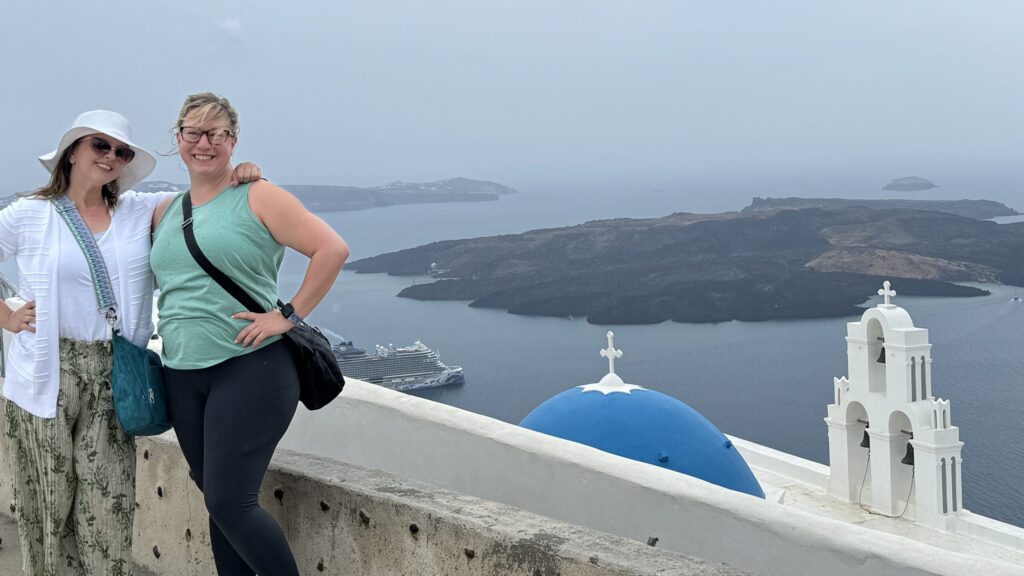
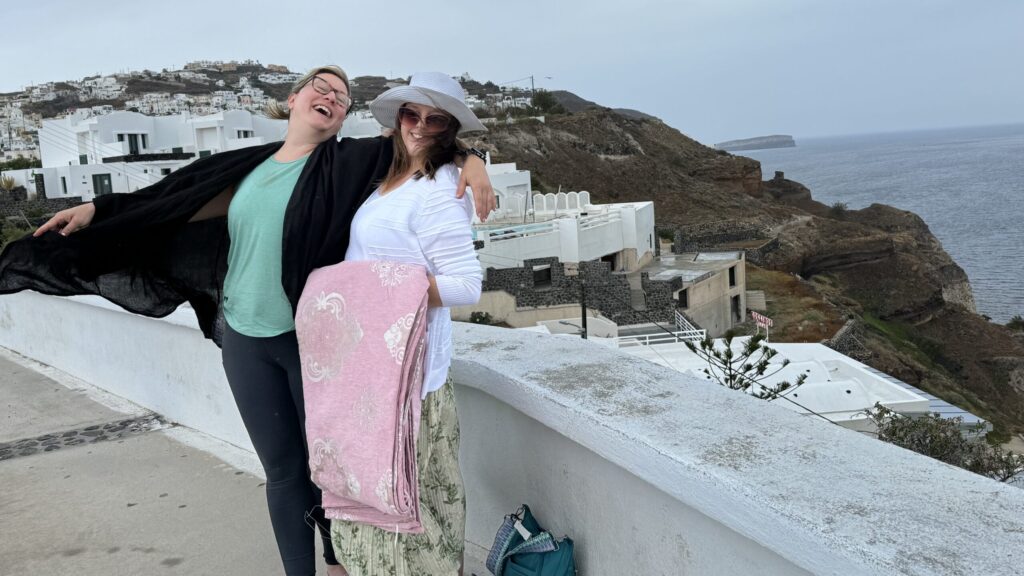
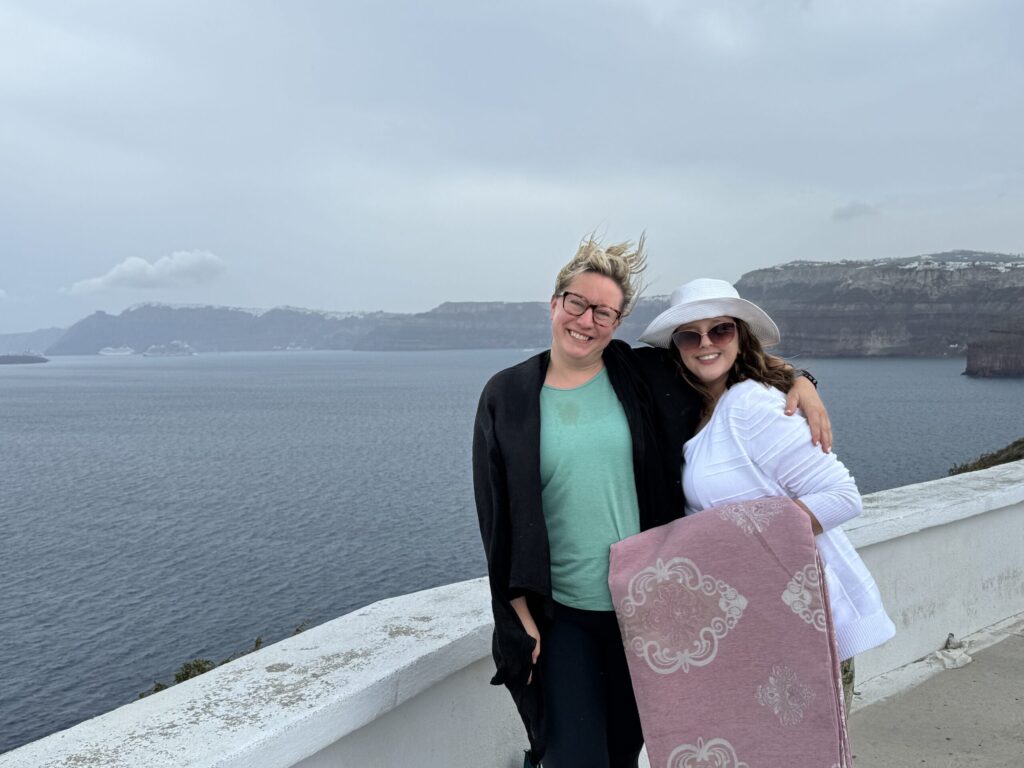
Ten minutes later, at another scenic overlook, we had what can only be described as a windswept editorial photo shoot starring L, the sea, and the giant pink blanket. We laughed so hard we scared off a flock of birds. It was delightful.
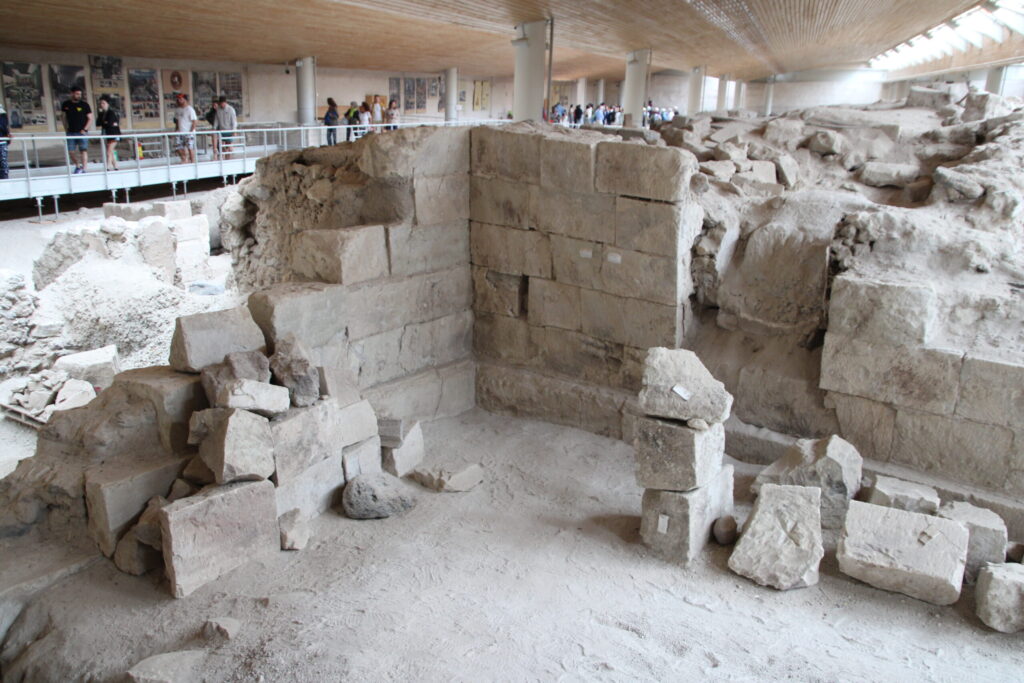
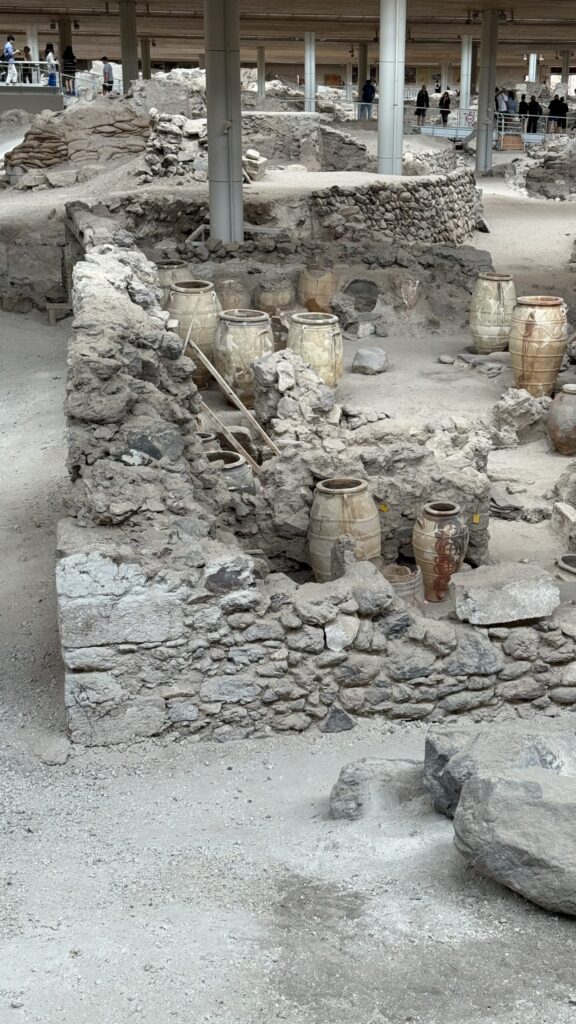
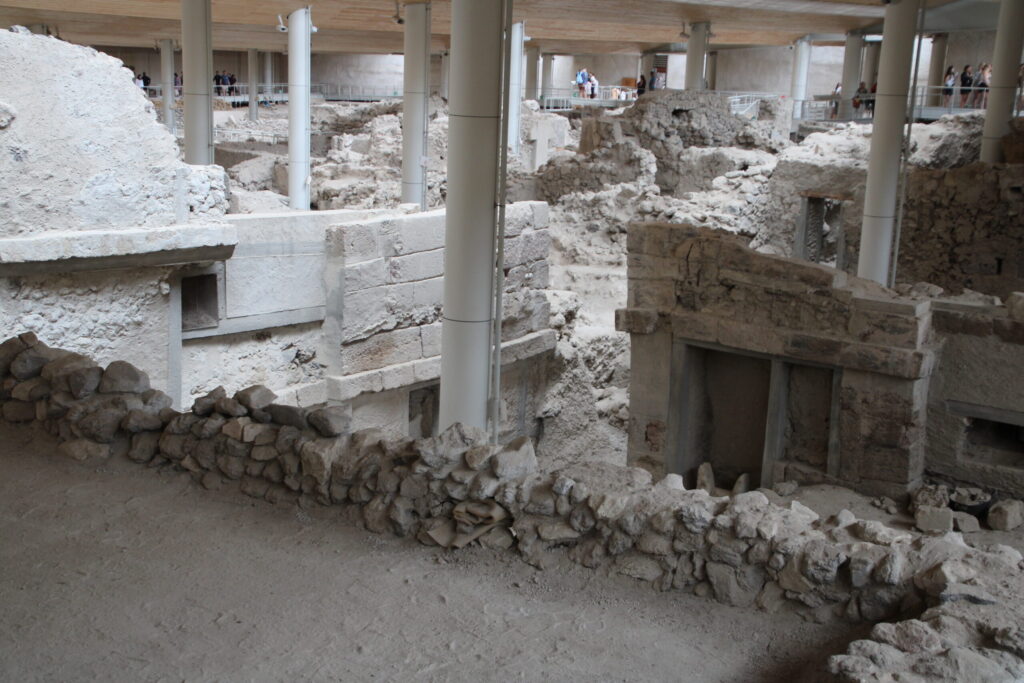
Then came the time-travel portion of our tour: Akrotiri, the Bronze Age city buried (and preserved) by a volcanic eruption nearly 4,000 years ago. It’s often called the Greek Pompeii — only, thankfully, without the body casts.
Raised walkways carry you above the ruins, where you can gaze down at the remains of a thriving port city, one of the most important of its time: multi-story buildings, drainage systems, wall frescoes, imported goods from across the ancient world. The preservation is mind-boggling. You can see how people lived, imagine their markets and kitchens, their daily lives.
It’s the kind of place that scrambles your brain — trying to reconcile the distance of millennia with the very human traces still visible in the ash and stone. I’ve had these moments all over Greece, but this one hit hard. Four thousand years ago, people were here. Building things. Falling in love. Telling stories. Maybe even arguing over where to get lunch.
It’s hard not to geek out. The engineering, the art, the fact that they had indoor plumbing when most of Europe was still figuring out forks? But what really got me was how real it all felt. Like if I blinked, I might catch someone ducking around a corner, late for market.
Exploring Emporeio: Castles, Bougainvillea & Glamour Shots Galore
From ancient ruins to medieval fortresses — Santorini really knows how to time-travel. Giannis steered us straight East to the Venetian Castle of Emporeio, one of five fortifications built to protect the island from pirates. When we arrived, it was blissfully deserted.
Yet another perk of having a local guide? He knew exactly when to hit each site to avoid the tour bus crowds.
Emporeio was a maze of narrow alleys, stark white walls, tiny brightly colored doors, and pops of bougainvillea so vibrant they looked photoshopped. We wandered past steep staircases (the kind I would have fallen down, given more time), found ornate bell towers, and entered through the lone remaining castle gate, imagining what life inside these protective walls might have looked like centuries ago.
At the Church of Panagia Mesiana, we admired its bell-filled façade. At Agios Spyridonos Church, we climbed to sweeping views of the village and the sea. And somewhere between those moments, the sun finally peeked out — cue photo shoot round two. We posed dramatically among the ruins, bathed in golden light, channeling our inner travel influencers and laughing the whole time. The vibe? Pure nonsense and silliness.
But eventually, we were hot, slightly sun-dazed, and more than ready for the next essential stop: lunch.
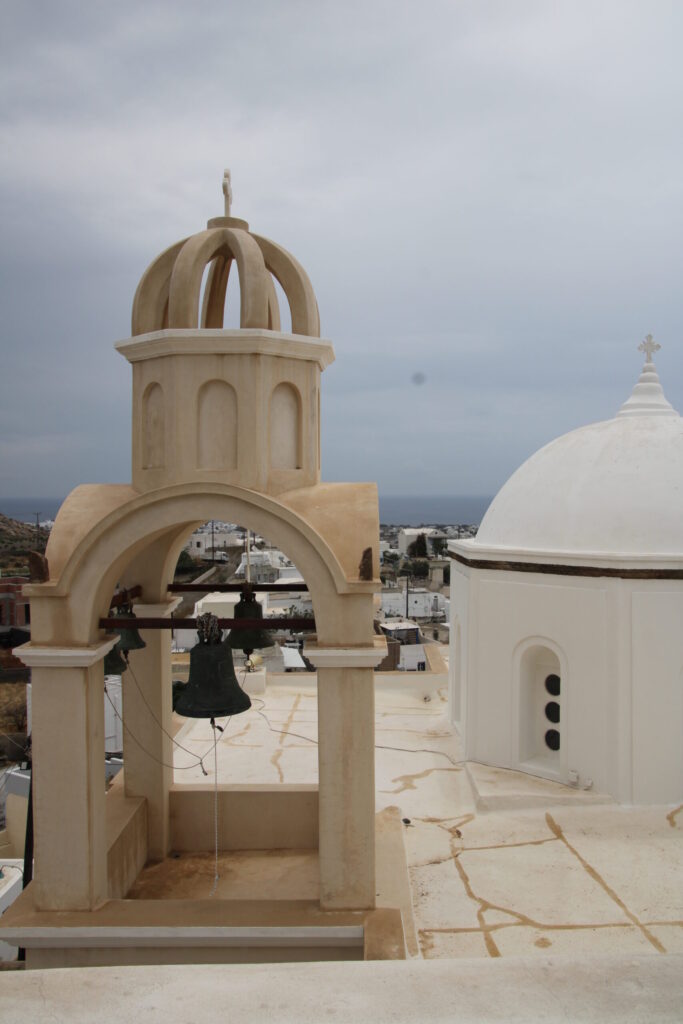
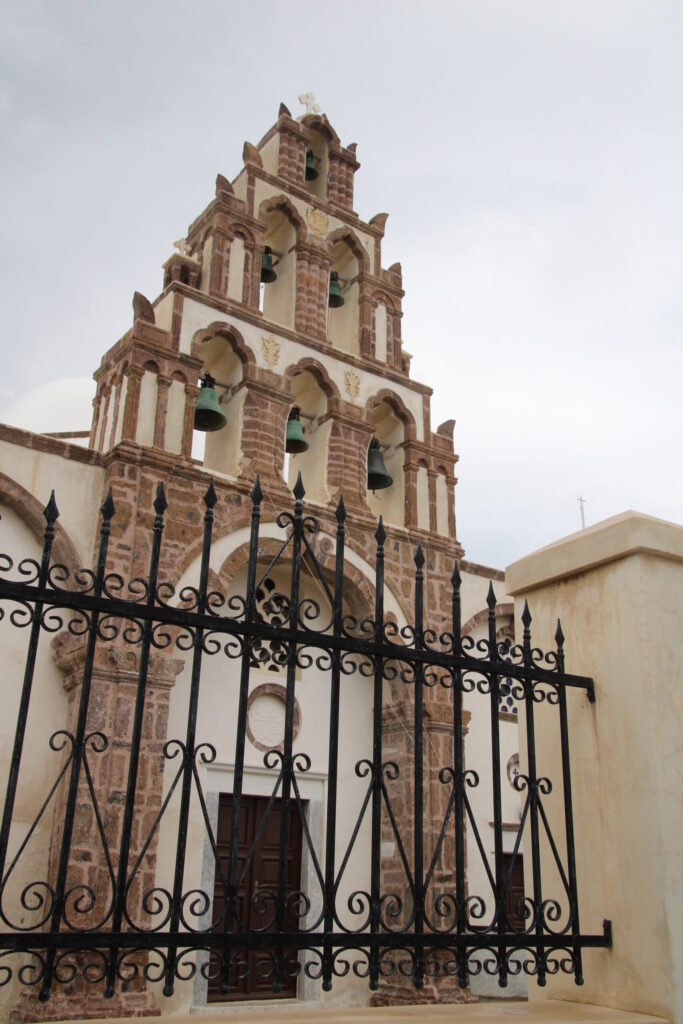
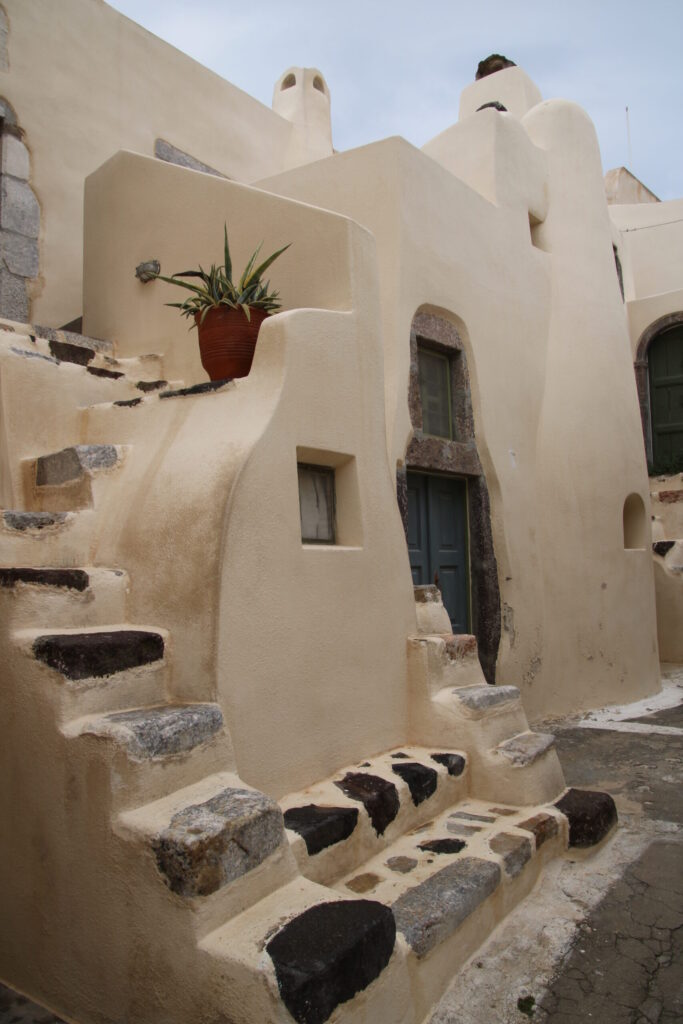
Ruins & Rewards: A Basilica and a Beachside Feast
On the way to lunch, we made a quick stop at the ruins of the 5th-century Basilica of Saint Irene — the site that may have given Santorini its name (Sant-Eirini = Saint Irene = Santorini). Today, it’s more of a skeletal outline than a full structure, but it’s humbling to gaze on stones that have seen over 1,500 years of history. A worthy pause before diving headfirst into one of the best meals of the trip.
Because then, friends, came Saavas Popeye — a tiny taverna tucked along the black sands of Perivolos Beach, far from the usual tourist trails. The place had an otherworldly calm to it, made even better by the fact that we were the only ones there.
Okay, technically it took me a full year to remember the name of the place. I had no signage photos, no receipts, just grainy food pics and a fuzzy memory of heaven. Eventually, I did what any travel-savvy millennial would do: I texted Giannis.
He replied in six minutes flat. Six. Minutes. A full year later. This is why I recommend private guides like him — the connection sticks.
Before lunch, we wandered the black sand beach, letting the chilly surf wash over our toes while clouds rolled theatrically above. I picked up a piece of volcanic rock — jet black and tumbled smooth by the waves, exposing the craggy pock marks — as a souvenir of the island’s explosive past. Something about that moment felt restorative, like my soul had taken a long exhale.Then we stepped inside, sun-kissed and salt-splashed, and sat down to a meal that would live in my memory forever.
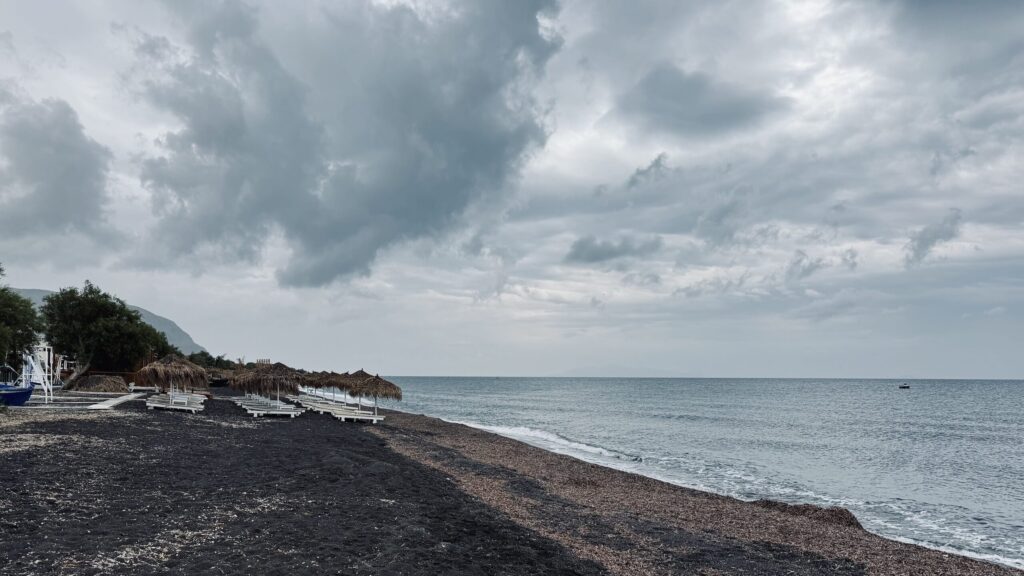
A Meal to Remember at Saavas Popeye
We sat at a breezy table near the half-walled front of the taverna, looking out over the jet-black sand and the glimmering Aegean. The sun had emerged just long enough to get us sweating, and the cool sea breeze was blissful. It was like dining inside a postcard.
Giannis waved toward an older man overseeing the restaurant like a benevolent sea captain. “That’s Popi,” he told us — the grandfather who founded the original Saavas Popeye back in 1954, when it was just a fisherman’s shack. Now in its third generation, they still source their seafood from their own fishing caique (boat), and every bite tastes like the ocean told a love story to your plate.
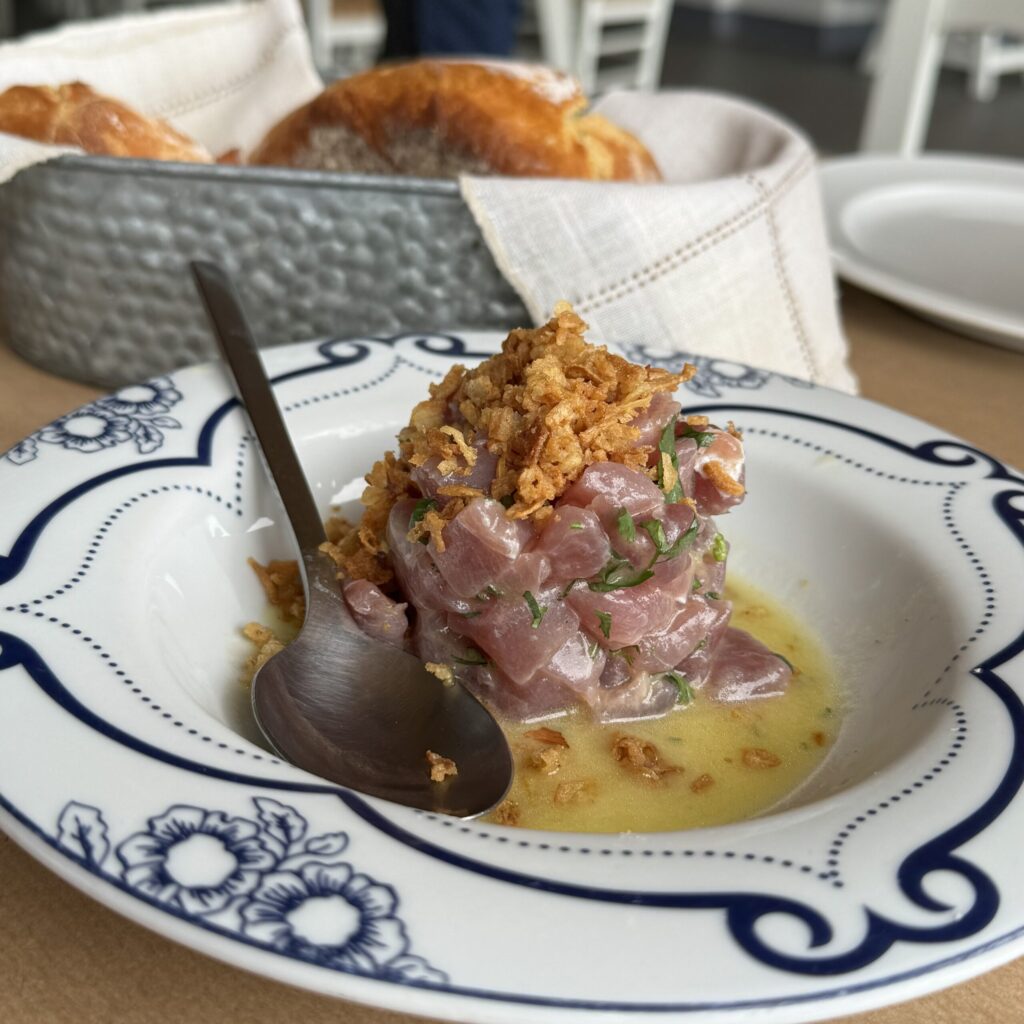
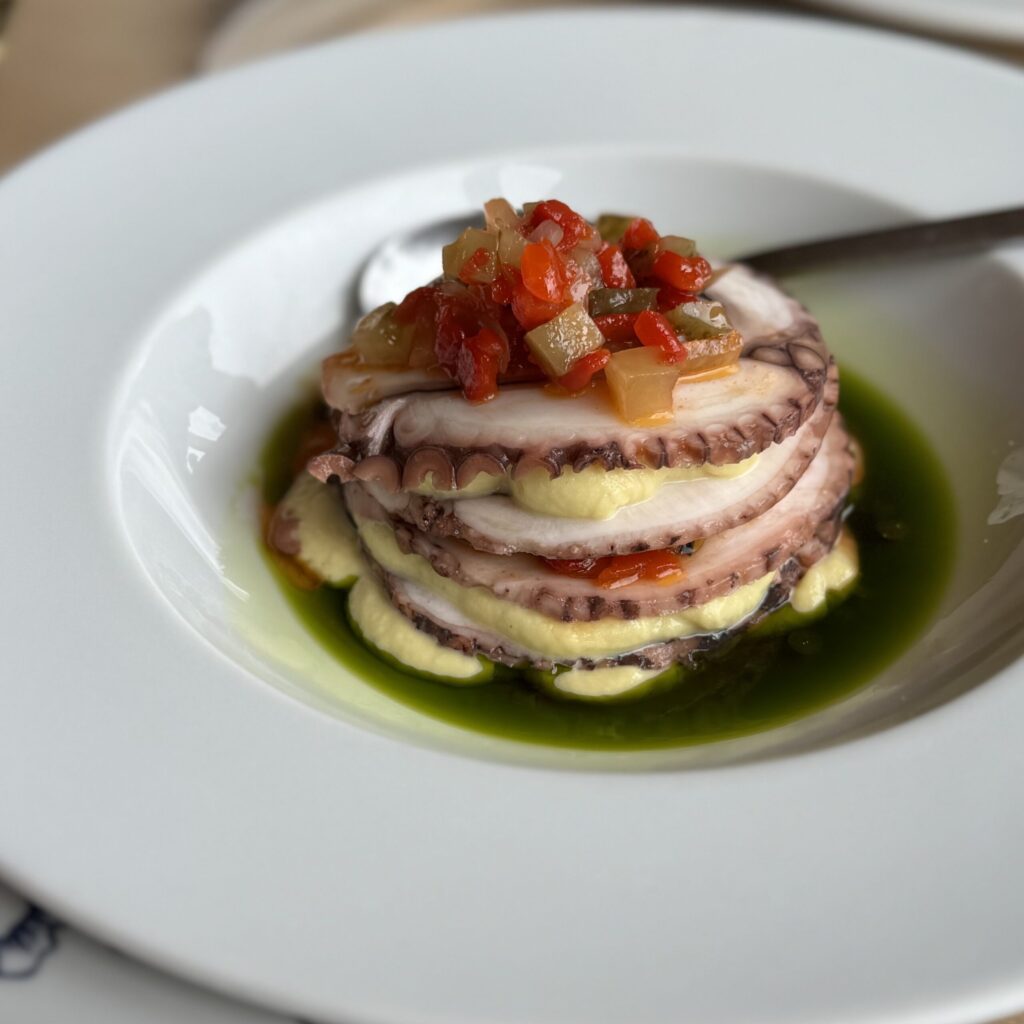
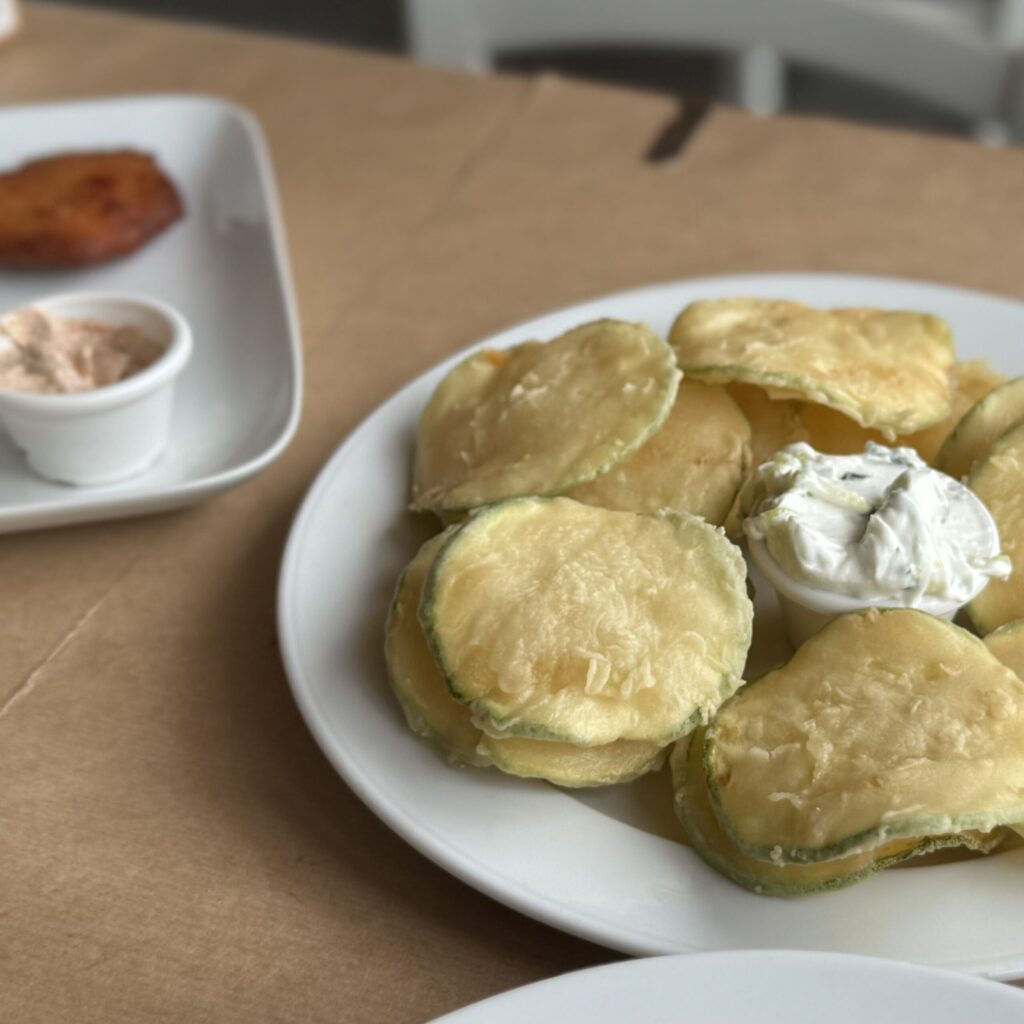
Under Giannis’ expert guidance, we ordered a feast:
- Octopus with fava puree — tender, elegant, and composed like edible poetry
- Tomato balls — light, crisp fritters with a tangy aioli
- Fried zucchini — impossibly thin, shatter-crisp, and paired with decadent tzatziki
- Tarama mousse — creamy, salty fish roe whipped to perfection
- Tuna tartare — citrusy and bright, topped with crunchy onions
Each dish felt intentional, harmonious, and somehow both simple and refined — every element shining brighter for being part of the whole, yet still intriguingly distinct. We ate slowly, laughed easily, and swapped stories with Giannis like we’d been friends for years, communing in that rare way that only seems to happen over a shared table.
And when we couldn’t possibly eat another bite, we did anyway — because saying no to food this good felt borderline disrespectful.
We politely refused the generously offered after-meal digestive liquor (a thing you must learn to do if you’re sober and in Greece). But it didn’t dim the moment — if anything, it deepened it. This wasn’t just lunch. It was a shared experience, a pause in the day that fed more than our stomachs.
One Last View, Two Goodbyes, and 588 Steps of Glory
Bellies full and hearts lighter, we made our way to our final stop with Giannis: Prophet Elias Hamilos, a whitewashed chapel perched at the highest point on the island. From this serene summit, we looked out over the caldera — still visible in all its sweeping drama — though the far-off islands blurred into the mist.
The cloudy skies gave everything an empty, almost deserted feeling. No crowds. No noise. Just us, the chapel, and the wind — loud and constant, echoing like waves crashing somewhere far below. It felt like the island was offering one last moment of serenity before we returned to the real world.
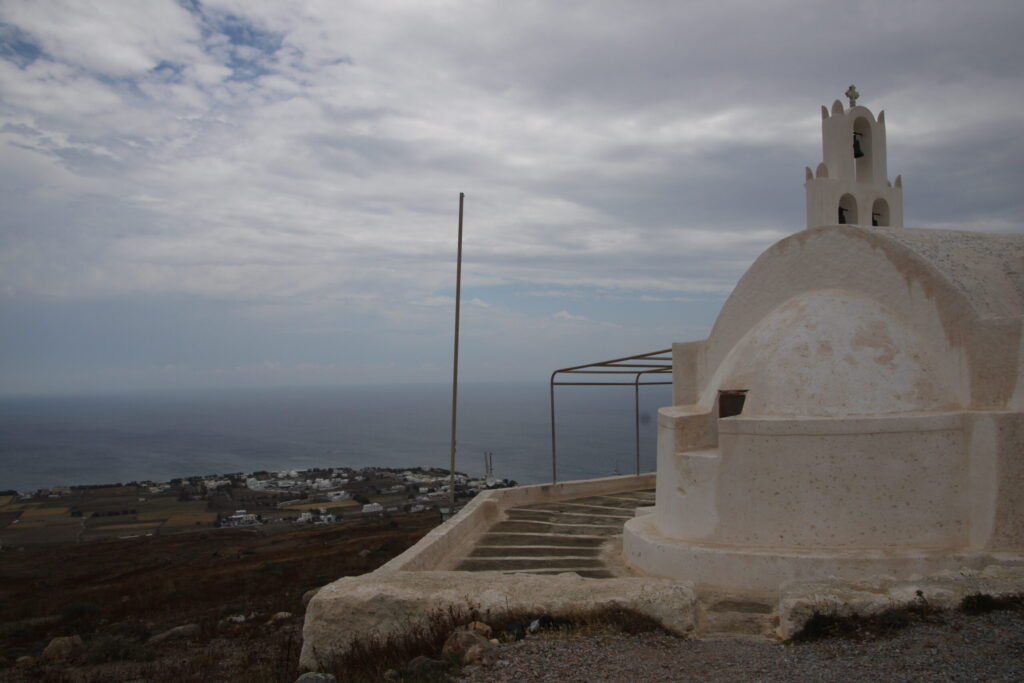
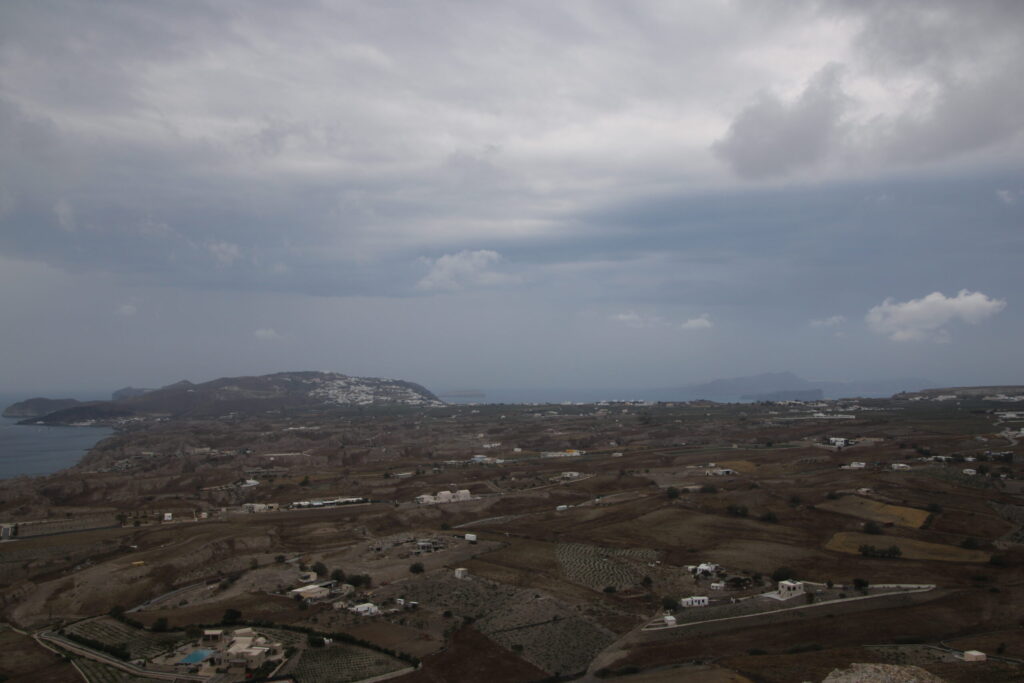
Then came the first goodbye.
Giannis dropped us at the edge of the old, car-free section of Fira, where we were set to explore the shops and sights before making our way back to the ship. We waved, said our thank-yous, and began wandering toward the cable car station…
…only for me to realize, 20 minutes later, that I no longer had my glasses.
The glasses I use to see things.
We texted Giannis in a panic. He spun the car around, fought his way back through traffic, and reunited me with my eyeballs. What a guy. He didn’t even pretend to be annoyed.
Cue goodbye #2, slightly more sheepish, but no less grateful
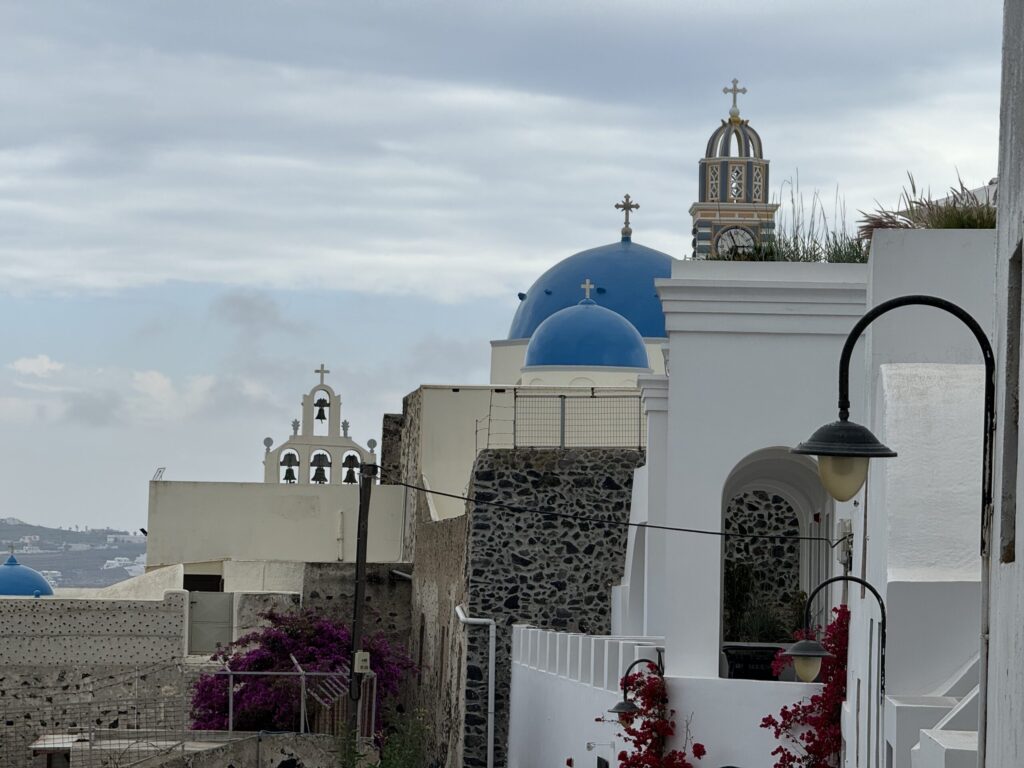
We could’ve easily spent hours more in Fira — exploring museums, peeking into galleries, lingering over iced coffees in cliffside cafés. Honestly, we could’ve spent days more in Santorini. There were hikes we didn’t take, beaches we didn’t see, hot springs we didn’t soak in. But that’s the nature of cruising: a sampler platter of unforgettable places, just enough to whet your appetite for more.
And by this point, we were toast. It was time to head back to the ship.
Armed with our prepaid tickets, we made our way to the cable car station, excited to float gently down the cliffside with panoramic views. Except… the line was insane. Like, three-hour-wait insane. Not-going-to-make-it-back-in-time level insane.
So we rallied. And took the stairs. All 588 of them.
Down the weathered Karavolades Stairs we went, zigzagging across the cliff face toward the sea. The views? Unreal. The terrain? Treacherous. Uneven cobblestones. Hairpin turns. Donkey droppings galore. (And yes, we could’ve ridden a donkey down, but L’s fear of all horse-adjacent creatures meant that was a no-go.)
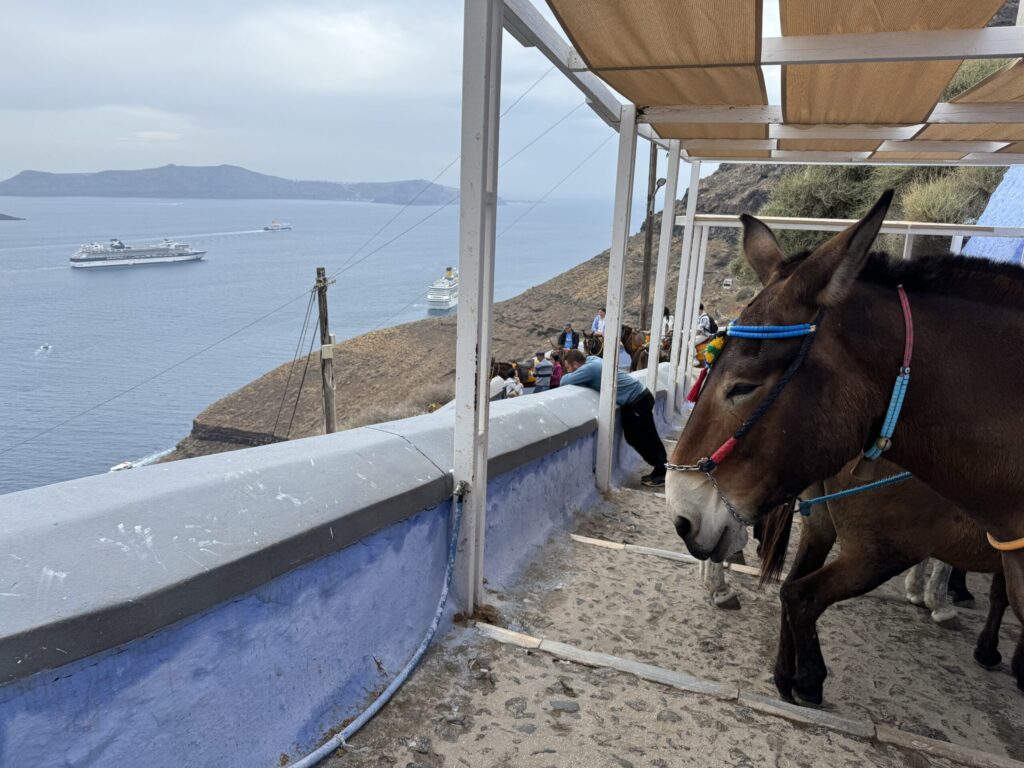
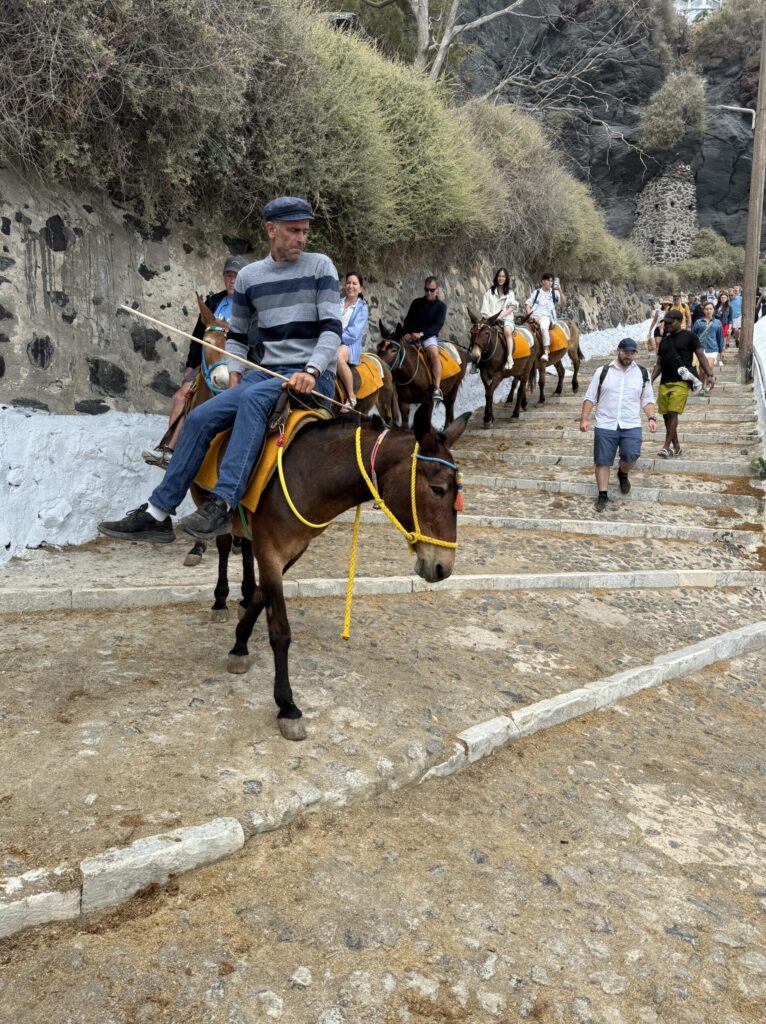
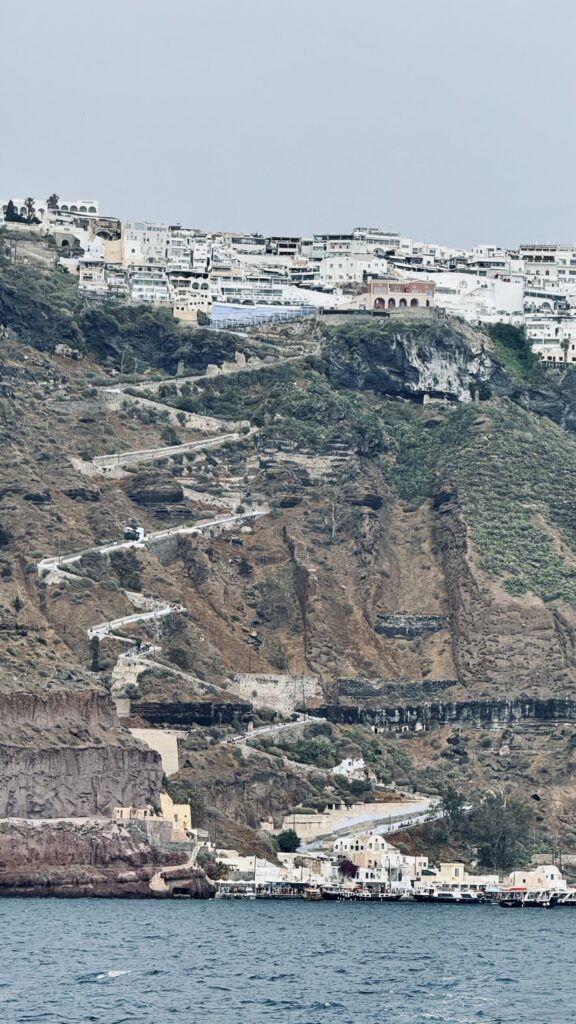
So we walked. Slowly. Carefully. Sweaty, giggling, and periodically gagging.
I took one dramatic spill on my well-padded backside — alarming everyone nearby but injuring only my pride and, thanks to the aforementioned donkey leavings, my sense of hygiene. Still, we made it to the bottom in one piece, feeling victorious in that ridiculous, slightly delirious way that only travel can deliver. (And slightly irritated when someone casually mentioned they’d walked up those stairs earlier that morning. Okay, showoff.)
Our one day in Santorini was over. But it didn’t feel rushed or incomplete. It felt… perfectly full.
I spent seventeen days in Greece on that trip — in Athens, on islands, at sea. And this day still stands out as one of the very best. Not because everything went smoothly. Not because we saw everything. But because somehow, everything aligned.
The place.
The people.
The laughter.
The unexpected weather and the meals and the blanket-buying detour.
Sometimes, travel gives you exactly what you didn’t know you needed. And sometimes, if you’re really lucky, it gives you one perfect day.
Santorini is one of those places I know I need to see again — maybe next time with sunshine, just for the contrast. It has everything: history, wild beauty, food that ruins you for all other food, and views that rewire your soul. And it’s a volcano. Volcanos always blow my mind.
Travel’s a gamble. You never know if you’re signing up for magic or a meltdown. But the risk is always worth it — for the connections I find in unexpected places, for the wonder I feel at discovering new pieces of the world and of myself, for the vibrant moments that lodge themselves into my bones. There is nothing like it. And every now and then everything comes together to make a perfect day, one that I could never have designed myself. These are the days I live for, and what I found in Santorini.
Want to Keep Wandering?
The adventure doesn’t stop here!
Dive into another of my favorite travel tales, tips, and sober chaos:
Or Crack open the chaos and explore my destinations, advice, and big ol’ feelings:
Want more weird, wonderful chaos in your inbox?
No spam. No nonsense. Just good stories and the occasional travel tip.

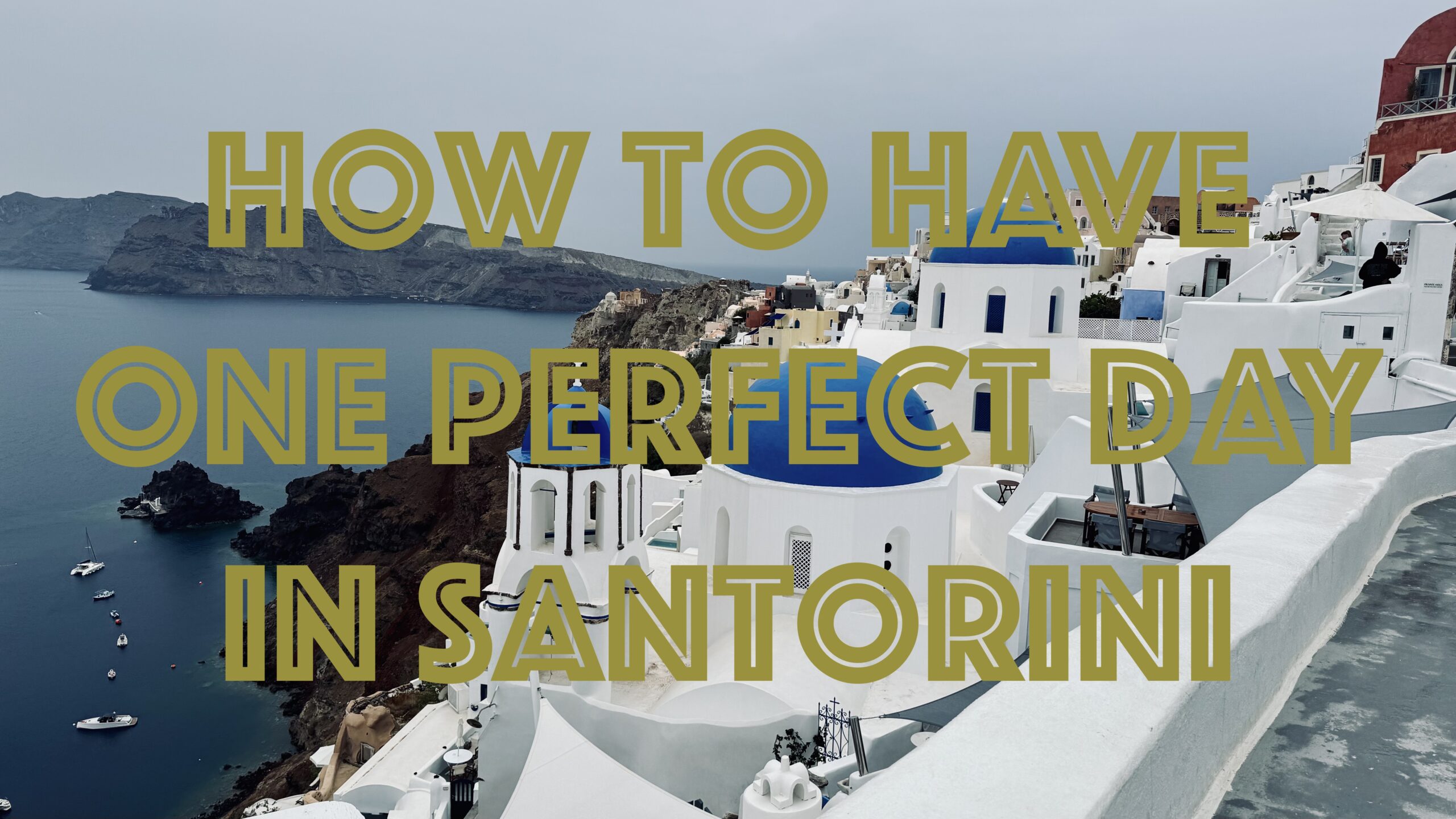
Leave a Reply